|

Class
of 2010 Breaks Record for Academic Achievement
| New Potomac House Welcomes
Freshmen | Coffee
and Conflict Resolution | Kagame
Discusses Healthcare | A
Credit to the Force | University
Welcomes New Trustees | Cancer
Institute Honors Donaldson | Dreams
in Action for Inner-City Youth | 2006
GW Leadership Retreat | Golf
Program Achieves New Level of Success | NBA
Picks Up Colonials | Clark
Discovery Yields Evolutionary Connection |
Fountain Day at GW’s
Mount Vernon Campus | Alumna
is First Female Space Tourist | Faculty
Focus | At A Glance
| GW in History
| A Faculty for Writing

Class of 2010
Breaks Record for Academic Achievement

|
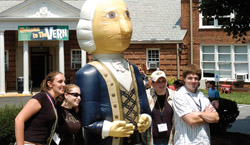
Jon Malis
|
GW’s incoming freshman class—with
nearly 2,400 members—sets the highest level
of academic achievement to date for the University.
The class average SAT score is 1920. They
represent the best of the 19,500 applicants GW
received for this academic year.
The Class of 2010 excels outside the classroom
as well—half of incoming freshmen participated
in a varsity sport; 14 percent served as editors-in-chief
of their school newspaper, literary magazine,
or yearbook; 16 percent participated in debate;
and 64 percent participated in community service
projects.
Incoming freshmen hail from all 50 states, the
District of Columbia, and nations all over the
world. African American and Latino American students
comprise 12 percent of the class, while the number
of international students coming to GW this year
increased by nearly 20 percent.
“One of the most rewarding aspects of
my job is welcoming the students who have chosen
to call GW ‘home’ for the next four
years,” says GW President Stephen Joel Trachtenberg.
“Each student truly is exceptional in his
or her own way, and I am always invigorated by
their enthusiasm, energy, and ultimately their
contributions to our campus community and the
city of Washington.”
The class was officially welcomed to the University
on Sept. 4 at Freshman Convocation in the Charles
E. Smith Athletic Center.
New Potomac House Welcomes Freshman

Potomac House residence hall, which
opened in August, offers modern amenities
as well
as special services for students interested
in arts and culture. Class-centered
programming is now offered at several
GW residence halls and is designed
to enhance students’ courses
of study.
Julie Woodford
|

|
Though it blends in well with its red-brick
neighbors, GW’s new Potomac House
residence hall stands out to new students;
more than half of this year’s freshman
class requested housing in the state-of-the-art
complex.
The 10-story, co-ed residence hall opened
in August, when 379 freshmen moved in. Most
students in Potomac House are living in
four-person, single-sex suites of two double
rooms with a shared bathroom. The facility’s
prime features include a food service venue,
cable TV connections in every room, and
individual Internet and phone lines for
each student. Additionally, there are study
and community rooms and laundry and kitchen
facilities.
Potomac House also features its own theme—culture
and arts—meaning extracurricular activities
and advisement are available for students
interested in related topics. Residents
involved in pursuits including screenwriting,
sculpture, and photography benefit from
events catered to their interests, such
as guest speakers or a group trip to a museum.
This is part of the new GW Housing Programs’
class-centered programming, designed to
have students’ living environments
enhance their courses of study.
Other residence halls are also hosting
themed houses based on curriculum, including:
The Science Village—composed of Clark,
Hensley, and Merriweather Halls—at
GW’s Mount Vernon Campus; the Media
and Public Affairs House at Somers Hall;
and the Global Perspectives and Diplomacy
House at Thurston Hall. Each house has class-specific
student staffs, composed of house proctors
for first-year students, house scholars
for second-year students, and house mentors
for third- and fourth-year students.
These new communities will make it easier
than ever before for new students to meet
friends and explore interests.
—Dan Williams |
Coffee and Conflict
Resolution
Livingston Explores
Recovery and Change in Rwanda

|
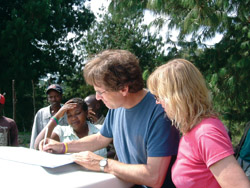
Professor Steven
Livingston and international coffee trade
expert Kim Easson (right) worked with Tutsi
and Hutu farmers in Rwanda to promote peace
and trade as Rwanda continues to recover
from the 1994 genocide of nearly one million
people.
|
During 100 days in 1994, nearly one million Tutsis
and moderate Hutus were massacred by Hutu extremists
in Rwanda, while much of the world stood silently
by. Steven Livingston, associate professor of
media and public affairs and international affairs,
was in the Southern Sudan studying that country’s
civil war when the Rwandan genocide began. He
tried to enter Rwanda with a group of journalists;
though they were turned back, “I saw bodies
washing up in Lake Victoria,” says Livingston,
who wrote about the crisis and was involved in
events marking its 10th anniversary. “I
resolved to return to the region with students
to focus on how Rwandan society has managed to
come to grips with its history.”
Livingston wanted his return to concentrate
on more than the sad history of the genocide,
which ended when Tutsi rebels, led by Gen. Paul
Kagame (now president of Rwanda) overthrew the
Hutu government and seized power. Rwanda has taken
significant strides since 1994, and Livingston
works to continue that progress. “Combining
my interest in political conflict with a friend’s
interest in Rwanda’s expanding coffee industry,
I organized a group trip to examine the role of
the specialty coffee industry as a basis for national
reconciliation and social harmony.”
Accompanied by Kim Easson, an expert on the
international coffee trade, six undergraduates,
a reporter, and the owner of a large coffee wholesaling
company on the West Coast, Livingston spent the
last week of May traveling through Rwanda.
“Kim Easson has a special interest in
coffee in Rwanda because coffee pumps much-needed
revenue into farming communities decimated by
the genocide,” Livingston explains. Livingston
and his team worked with the Maraba Coffee Cooperative,
a USAID-funded enterprise that brings together
Hutu and Tutsi farmers working for a better life.
“The Hutus and Tutsis get to know and understand
each other by working side by side processing
coffee, thus helping to erode the distrust and
anger that remains.”
Now in his 16th year at GW, Livingston teaches
courses on media, war, and foreign policy. For
the past two years, he served as interim director
of the School of Media and Public Affairs and
director of the political communication program.
Before the students and his colleagues arrived,
Livingston conducted a four-day media workshop
for 30 Rwandan government officials, covering
topics such as international image and the principles
of a vibrant free press in a democracy. Part of
the State Department’s speaker program,
the workshop took place at the Hotel Des-Milles
Collines, the real Hotel Rwanda.
—Jamie L. Freedman
Kagame
Discusses Healthcare
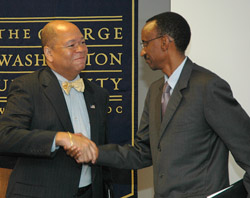
Provost and Vice President for Health
Affairs John F. Williams, left, and
Rwandan President Paul Kagame
Thom Kohout
|

|
Rwandan President Paul Kagame
spoke on the future of Rwanda and Africa
on campus as part of the GW Africa Center
for Health and Human Security’s Presidential
Lecture Series. Faculty members, students,
and current and former members of the international
affairs community heard about Rwanda’s
ongoing recovery efforts from the 1994 genocide
that resulted in nearly one million Tutsi
deaths by Hutu extremists.
Kagame also met with GW Medical
Center leaders to discuss possible collaborations
to help improve Rwanda’s strained
healthcare infrastructure, particularly
HIV/AIDS treatment. |
A Credit to the Force
University Police Department
Receives Accreditation
GW’s University Police Department received
accreditation from the Commission on Accreditation
for Law Enforcement Agencies, joining the select
1 percent of college and university police departments
in the nation to earn the designation.
CALEA also accredits local and federal law enforcement
entities. DC’s Metropolitan Police Department
and Georgetown University’s Public Safety
Department are currently seeking accreditation,
and UPD Chief Dolores Stafford and UPD Accreditation
Manager Mark Balazik serve as CALEA assessors.
The UPD underwent a rigorous, five-phase process
to receive accreditation, beginning with an application
four years ago. UPD submitted proofs of compliance
for each of the 450 standards set by CALEA, underwent
several on-site assessments, and attended a public
hearing during which CALEA heard testimony from
agency personnel, assessors, staff, and community
members.
“I always believed that we were one of
the better campus police departments on the East
Coast. This gave us the opportunity to prove that
it was true,” Stafford says of the application.
She now works to make sure the meaning of the
achievement is known to the GW community, especially
parents.
As an accredited agency, UPD is required to
comply with new standards as they are developed,
such as training its staff in incident command
and emergency preparedness that meets the standards
of the National Incident Management System. Operating
procedures, personnel practices, equipment, and
facilities are all subject to meeting CALEA standards.
UPD officers and staff members are proud of
the distinction. “It has helped morale tremendously,”
Stafford says. “Our officers feel a sense
of pride for being part of the department.”
The honor also has supported the department’s
recruitment efforts. “Because of the accreditation,
we’re getting a good mix of candidates—not
only ones coming out of college, but those who
already have law enforcement experience and who
are interested in campus law enforcement as a
career opportunity.” She also notes that
more than 60 percent of UPD officers have already
earned a college degree.
Stafford credits the positive work environment
at GW with her staff’s longevity. Twenty-five
percent of her officers have been watching over
the University for more than 15 years and 30 percent
have been at GW between five and 10 years.
—Maureen Ryan

University Welcomes
New Trustees

|
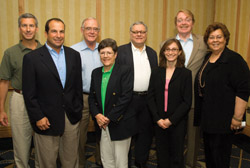
Five new members
joined GW’s Board of Trustees this
summer. (From left to right, back row):
Steven S. Ross, Board of Trustees Chairman
Charles T. Manatt, GW President Stephen
Joel Trachtenberg, James F. Humphreys; (from
left to right, front row): Robert K. Tanenbaum,
Board of Trustees Vice Chair Patricia Gurne,
Julia Zoë Beckerman, and Board of Trustees
Secretary Lydia Thomas. Not pictured: Cynthia
Steele Vance.
Dave Scavone
|
The GW Board of Trustees elected five new members
in June, who assumed responsibilities in July.
The board provides governance and counsel on the
management, direction, and strategic plan of the
University.
The new charter trustees are: James F. Humphreys,
JD ’78, president of James F. Humphreys
& Associates; Robert K. Tanenbaum, JD ’82,
principal, Lerner Enterprises and Washington Nationals
ownership group; and Cynthia Steele Vance, MVC
’79, a former news anchor for WTTG-TV/Fox
5 in Washington.
The new alumni trustee is Steven S. Ross, BBA
’81, senior vice president of Ferris Baker
Watts. The young alumni trustee is Julia Zoë
Beckerman, JD ’05, graduate certificate
in health policy ’05, an associate with
Feldesman Tucker Leifer Fidell.
Charter and alumni trustees each serve four-year
terms, with a limit of three consecutive terms
for charter trustees and two terms for alumni
trustees. The young alumni trustee position is
limited to one, four-year term.
“We welcome the input of this new strong
group of leaders,” says GW Board of Trustees
Chairman Charles T. Manatt. “Each trustee
plays a vital role in the governance of the University
and the future of the institution.”
GW President Stephen Joel Trachtenberg added,
“Our new trustees join The George Washington
University at a very exciting and challenging
time in our history. The University is fortunate
to have informed members of the Board of Trustees
who actively participate in helping shape the
direction of GW as it builds on past and current
successes as a world-class research and teaching
institution serving in the nation’s capital.”
Cancer
Institute Honors Donaldson
Steven Patierno, executive director of
the GW Cancer Institute, presented acclaimed
journalist Sam Donaldson with the Spirit
of Life Award at the Third Annual GW Cancer
Institute Gala this spring. The event honors
advocates, leaders, and researchers dedicated
to cancer prevention and treatment. Proceeds
benefit the institute, an urban oncology
center dedicated to understanding and alleviating
disparities in cancer treatment. More information
about the institute and next year’s
gala can be found at www.gwcancerinstitute.org. |

Dreams in Action for
Inner-City Youth

|

GW senior John Muller (left) and Morehouse
College senior Justin McNeil, founders of
DreamCity Theater Group, which helps members
develop business as well as artistic skills.
DreamCity Theater Group
|
For GW senior John Muller, founding a public
theater project in inner-city Washington was a
matter of practical idealism. After encountering
“arts-related programs that didn’t
teach life skills,” Muller tried a different
approach. Along with creative expression, young
people need “to understand basic tenets
of business, such as having a bank account, knowing
how to compose a resume, and the process of networking
and following up,” Muller says. His company,
DreamCity Theater Group—founded with Morehouse
College senior Justin McNeil—develops skills
not usually addressed by artistic organizations.
Students involved with DreamCity learn about staging
productions and acquire skills that also empower
them offstage.
Muller gained business knowledge at GW, which
“places a high premium on organization and
structure.” Armed with an understanding
of “how policymakers operate and make decisions,”
Muller and McNeil created an organization that
is as pragmatic in its approach as it is idealistic
in its ambition.
Muller and McNeil’s play, The 70,
which originated in a GW playwrighting class,
previewed this summer at the D.C. Hip-Hop Theater
Festival. Ten free performances were shown over
three weeks at the Martin Luther King Jr. Memorial
Library, drawing more than 2,300 audience members.
Funded, crewed, and performed by members of the
public, The 70—which depicts the disparate
lives of bus passengers united in their commute
through the heart of the city—demonstrates
Washington’s diversity in its execution
and content.
Muller works to familiarize the GW population
with the urban community that surrounds it, and
vice versa, saying “education is the key
to becoming independent and self-reliant.”
Much of his service effort has been devoted to
making underprivileged children—for whom
he says private colleges are often stigmatized—comfortable
in a collegiate environment. In addition to his
work with DreamCity and its subsidiary, DreamCity
Poets, he also founded GW Mentors, a tutoring
and leadership organization that pairs GW students
with middle school students enrolled in a local
chapter of the national Higher Achievement Program.
After graduation, he plans to remain in the District
and continue public service.
“For communities where there is hopelessness,
art is a transforming power,” Muller says.
In its businesslike optimism, DreamCity is primed
to make that goal attainable as well as uplifting.
—Ruth Steinhardt
2006
GW Leadership Retreat
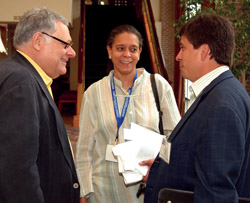
President Stephen Joel Trachtenberg
and Board of Trustees members Michele
Hagans, MBA ’94, and Nelson
Carbonell, BS ’85, meet between
breakout sessions at the 2006 GW Leadership
Retreat.
Dave Scavone
|

|
In June, the University conducted a Leadership
Retreat at which President Stephen Joel
Trachtenberg, members of the Board of Trustees,
the GW Alumni Association board, and school
advisory councils, as well as vice presidents
and deans, gathered for lively discussions
about GW’s future. The three-day event
was held at the Hyatt Regency Chesapeake
Bay in Cambridge, Md.
Meetings and breakout sessions addressed
topics including the challenges that higher
education institutions face to meet the
needs of 21st-century students and society.
Participants also discussed engaging alumni
in the University’s mission and the
role of philanthropy in GW’s future
success. |

Golf Program Achieves
New Level of Success

|

(Left to right) Raman
Luthra, Juan Pablo Zuluaga, Dan Mirabella,
Andrew Gallo, Brian Carroll, and head coach
Scott Allen qualified for the NCAA golf
tournament for the first time in 60 years
last season.
GW Athletics
Communications
|
Overcoming some of the hindrances associated
with building a varsity golf program in a metropolis,
coach Scott Allen and the GW golf team produced
a landmark season this spring, qualifying for
the NCAA tournament for the first time in 60 years.
The Colonials received an at-large bid to the
NCAA’s East Regional last May, facing off
against some of the nation’s top teams at
the Lake Nona Golf & Country Club in Orlando,
Fla., ultimately finishing 23rd.
Now in his 13th year as coach, Allen says the
program was struggling when he took the job. Since
then, Allen and his players have worked hard to
improve, with successes coming incrementally.
Receiving a bid to the NCAAs was the biggest breakthrough
so far. “This was a goal a lot of us have
had for a long time. It was a special thing for
our former players, too, not just the guys on
the team now,” Allen said. “It was
a culmination of a lot of years of chipping away.”
Leading the way for GW throughout the season
was Brian Carroll, BBA ’06, who may be the
best golfer in school history, according to Allen.
Carroll earned 10 top-10 finishes on the season
and received GW’s J. Dallas Shirley Outstanding
Senior Male Athlete Award. Allen says Dan Mirabella,
BBA ’06, and Andrew Gallo, BA ’06,
also were a big part of the team’s success.
One of the strategies Allen has used to bolster
the program is to turn a natural disadvantage—GW’s
distance from any golf course—into a team-building
experience. The Colonials commute to courses around
the D.C. area in order to practice, and they compete
for recruits against many schools that have courses
on or near their campuses. Allen has tried to
use those trips to foster chemistry, deemphasizing
the individual nature of the sport.
“I actually think that can be an advantage
for us. We do everything together, including travel
to practice,” Allen says. “It makes
us a close-knit team.”
The coach describes his strategy as a slow,
ladder-climbing process. Each time the Colonials
achieve good results, it increases the chances
that they’ll be invited to better tournaments.
When they’re invited to better tournaments,
they can attract a higher level of recruits.
This season, seniors Tim Johnson, Bob Rohr,
and Raman Luthra are charged with the task of
leading GW to greater heights; the team doesn’t
view simply making the NCAA tournament as the
end goal. Eventually, Allen wants to see the program
emerge as the best in the northeast, with postseason
bids becoming par for the course.
—DW
NBA
Picks Up Colonials
Former Colonials basketball stars Pops
Mensah-Bonsu, BA ’06, and Danilo Pinnock
took fans along for an amazing ride during
their time at GW, and supporters won’t
be forgetting them anytime soon. Now the
two are pursuing careers in the NBA.
After going undrafted during the summer,
the outlook improved for Mensah-Bonsu. The
6’8” London native signed a
free-agent contract with the Dallas Mavericks,
last year’s NBA Finals runner-up,
in August. The contract is guaranteed for
one year with a team option for a second.
Mensah-Bonsu earned it by impressing the
franchise with his efforts in the NBA-sanctioned
Las Vegas summer league, where he averaged
8.8 points and 5.4 rebounds per game at
forward.
Pinnock, a 6’5” guard, was
drafted by the Mavericks in the second round,
but was traded to the Los Angeles Lakers
shortly thereafter. Pinnock signed a contract
with the Lakers in September. Both players
were part of GW’s 27-3 team last season
that won the Atlantic 10 title with a 16-0
record and made the second round of the
NCAA tournament.
—DW |

Clark Discovery Yields
Evolutionary Connection

Professor James Clark led a research
team in China that unearthed Yinlong downsi,
the oldest known remains of ceratopsian
dinosaurs. |

|
In the Xinjiang province in northwestern China,
professor James Clark led an excavation team that
unearthed a unique and revealing fossil, the oldest
known remains of a ceratopsian dinosaur. The remains
of this creature—Yinlong downsi—share
features with a different type of dinosaur, pachycephalosaur,
confirming an evolutionary connection previously
theorized.
Yinlong lived during the Late Jurassic
period, about 160 million years ago, making it
20 million years older than any other known ceratopsian.
Of the later ceratopsians, one of the most recognized
is triceratops, which was about the size
of a car and had three horns on its face and a
large boney frill. Yinlong was much smaller
than later ceratopsians—just over four feet
full grown—and didn’t have all of
the same pronounced characteristics, but does
have a triangular-shaped skull and rostral bone,
a distinct beak-like bone at the end of its snout.
Clark’s discovery also shares traits with
pachycephalosaurs, such as the placement of low
knobs on the back of the skull. Dinosaurs of this
classification, such as stygimoloch,
had dome-shaped skulls with thickened bones and
high foreheads. Pachycephalosaurs and ceratopsians
are two of the most specialized groups of dinosaurs,
and Yinlong is a primitive transitional
form with features that span the two groups. “Yinlong
provides concrete evidence that the evolutionary
relationship is indeed real,” says Clark.
“It shows that the common ancestor of the
two groups had pachycephalosaur features that
were then lost with ceratopsians.”
The actual excavation took place in 2004. Clark
worked alongside Xu Xing of the Institute of Vertebrate
Paleontology and Paleoanthropology in Beijing.
This year, Clark and Xing, along with two other
colleagues, published the discovery in the May
17 online edition of the British science journal
Proceedings of the Royal B: Biological Sciences.
Yinlong’s name comes from two
unrelated sources. The first half is rooted in
popular film. In Chinese, “yin” and
“long” mean “hiding” and
“dragon,” respectively. The 2000 Taiwanese
martial arts flick Crouching Tiger Hidden Dragon
was filmed in the same area where the fossil discovery
was made. The second part of the name is a tribute
to a deceased colleague, Will Downs, who worked
with Clark and Xing on a number of expeditions.
This is one of several breakthroughs for Clark
and company during their efforts in China. In
earlier work, they unearthed the most complete
skeleton of a land-based crocodilian from the
Middle Jurassic period, and they also discovered
the oldest tyrannosaur, a distant ancestor of
Tyrannosaurus rex. Clark, Ronald B. Weintraub
associate professor of biology, has conducted
digs in Xinjiang since 2001.
—DW
Fountain
Day at GW’s Mount Vernon Campus

|

Jon Malis
|
This spring, more than 1,200 students and
members of the University community celebrated
Fountain Day at GW’s Mount Vernon
Campus. The annual event, during which the
fountain is turned on in anticipation of
summer, is sponsored by students; the tradition
began while the campus was known as Mount
Vernon College.
Music by Aqualung, Ben Lee, and Augustana
set the tone for activities including dancing
and tie-dye art.
The Mount Vernon Campus also will host
Octoberfest on Oct. 21 during Colonials
Weekend. |

Alumna is First Female
Space Tourist
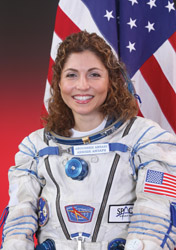 Anousheh
Ansari, MS ’92, became the first woman—and
only the fourth person—to become a space
tourist. On Sept. 18, Ansari accompanied 14 crew
members of the U.S.-Russian Expedition onboard
the Souyuz TMA-9 mission to the International
Space Station. The launch occurred from the Baikonur
Cosmodrome in Kazakhstan. Anousheh
Ansari, MS ’92, became the first woman—and
only the fourth person—to become a space
tourist. On Sept. 18, Ansari accompanied 14 crew
members of the U.S.-Russian Expedition onboard
the Souyuz TMA-9 mission to the International
Space Station. The launch occurred from the Baikonur
Cosmodrome in Kazakhstan.
Ansari—an engineer and founder of Prodea
Systems, a digital home and multimedia management
technologies firm—says she has dreamed of
space travel since childhood. The estimated cost
of her 10-day trip was $20 million.
The Iranian-born Ansari immigrated to the United
States at age 14. In addition to her GW degree
in electrical engineering, she now is pursuing
a master’s degree in astronomy from Swinburne
University in Australia.
Ansari and her family have encouraged space
tourism by providing the title sponsorship for
the Ansari X Prize, a $10 million cash award for
the first non-governmental organization to launch
a reusable manned spacecraft into space twice
within two weeks. In 2004, the feat was accomplished
by aerospace designer Burt Rutan. Ansari also
is part of a team working to develop a new
kind of spacecraft to encourage space tourism
among the broader public by making it more affordable.
|










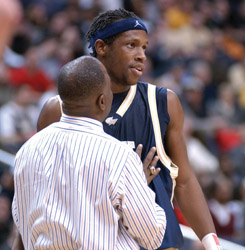
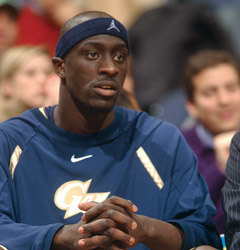


 Anousheh
Ansari, MS ’92, became the first woman—and
only the fourth person—to become a space
tourist. On Sept. 18, Ansari accompanied 14 crew
members of the U.S.-Russian Expedition onboard
the Souyuz TMA-9 mission to the International
Space Station. The launch occurred from the Baikonur
Cosmodrome in Kazakhstan.
Anousheh
Ansari, MS ’92, became the first woman—and
only the fourth person—to become a space
tourist. On Sept. 18, Ansari accompanied 14 crew
members of the U.S.-Russian Expedition onboard
the Souyuz TMA-9 mission to the International
Space Station. The launch occurred from the Baikonur
Cosmodrome in Kazakhstan.